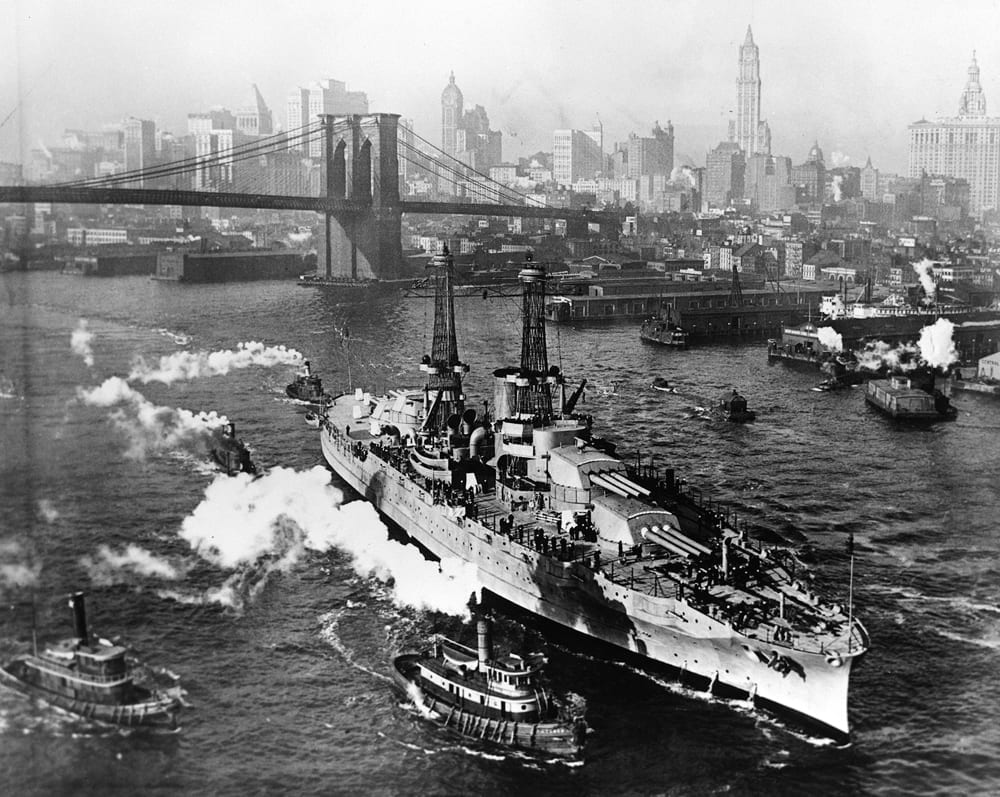History of the U.S. Navy battleship USS Arizona (BB-39) including information about asbestos exposure for workers.

The USS Arizona (BB-39) was ordered for the U.S. Navy on March 4, 1913. Her keel was laid down at the Brooklyn Navy Yard on March 16, 1914. She was launched on June 19, 1915 and commissioned on October 17, 1916 with Captain John D. McDonald in command.
USS Arizona joined Battleship Division 8 (BatDiv 8) on April 4, 1918 just before the United States entered World War I. She operated out of Norfolk, patrolling the eastern seaboard and serving as a gunnery training ship. After the November 11, 1918 armistice, the battleship rendezvoused with the USS George Washington, which was carrying President Woodrow Wilson to the Paris Peace Conference, to serve as part of the honor escort. She helped repatriate 238 veterans, arriving at Ambrose light station on Christmas Day 1918.
The USS Arizona sailed for Hampton Roads before returning to her base at Norfolk in January 1919. On February 4, she sailed for Guantanamo Bay for battle practices and maneuvers before heading to Trinidad. Later, the battleship headed to Brest and then Smyrna to protect American lives during Greek occupation of the port. American citizens sheltered onboard until it was safe for them to return to shore.
Later that year, USS Arizona headed to the New York Navy Yard for upkeep and removal of six of its original 22 guns. She joined BatDiv 7 in January 1920 for winter and spring maneuvers in the Caribbean, operating out of Guantanamo Bay. The battleship spent the second half of 1920 operating out of New York. She was given the hull classification symbol BB-39 on July 17 and became the flagship for Commander Battleship Division 7 (ComBatDiv 7) on August 23 under the command of Rear Admiral Edward V. Eberle.
Between this time and the beginning of World War II, the USS Arizona served in a number of different locations. She served variously at Guantanamo Bay, the Panama Canal Zone, Peru, Balboa, New York, Cape Charles, San Diego, San Pedro, the West Indies, the waters between Hawaii and the West Coast, Puerto Rico, the Virgin Islands, and the northern Alaskan waters. The battleship underwent modernization at the Norfolk Navy Yard from 1929 to 1930, upgrading armor, armament, and other ship components.
After being overhauled at Puget Sound Navy Yard in late 1940, the USS Arizona returned to Pearl Harbor for intensive training with the Navy’s Pacific Fleet. She completed a night firing exercise with the USS Nevada and USS Oklahoma on December 4, 1941.
The USS Arizona’s air raid alarm went off around 0755 on the morning of December 7, 1941. Five minutes later, the Japanese dropped a bomb that hit the side of turret No. 4 and went off into the deck below. This started a small fire but caused only minimal damage. At 0806, another bomb hit between and to starboard of turrets No. 1 and No. 2, which detonated the ammunition magazine located in the armored section under the deck. The resulting explosion destroyed the forward part of the ship. It has been agreed upon that the black powder magazine went up first, which when ignited the smokeless powder magazine. The fires burned for two days, showering debris down on Ford Island, and ironicalls putting out fires aboard the nearby repair ship USS Vestal.
Lieutenant Commander Samuel G. Fuqua earned the Medal of Honor for his attempts to put out the fires and get survivors off the ship. The Medal of Honor was posthumously awarded to Rear Admiral Isaac C. Kidd and Captain Franklin Van Valkenburgh for their bravery during the assault.
The blast destroyed the USS Arizona and sank her, killing 1,177 of the 1,400 crewmen who were on board – more than half of the casualties taken by the entire fleet during the attack on Pearl Harbor.
USS Arizona was struck from the Naval Vessel Register on December 1, 1942. The wreckage remains as part of the USS Arizona Memorial at Pearl Harbor. The battleship was awarded on battle star, and she was listed on the National Register of Historic Places on October 15, 1966. She was designated a National Historical Landmark on May 5, 1989.
Like other Navy ships of its time, the USS Arizona was built using a number of asbestos-containing components. Asbestos was prized for its resistance to fire, heat, water, and corrosion, so it could be found in valves, boilers, gaskets, turbines, incinerators, engine rooms, hot water pipes, steam pipes, fire doors, floor and ceiling tiles, wall insulation, and electrical wiring. Anyone who served aboard or did repair and maintenance work on these older Navy ships was exposed to dangerous levels of asbestos without the benefit of protective clothing, respiratory gear, or adequate ventilation.
Asbestos fibers are dangerous when inhaled or ingested, as they can become lodged in the lungs and digestive tract. This can result in a number of serious asbestos-related illnesses, including asbestosis, mesothelioma, lung cancer, esophageal cancer, stomach cancer, colon cancer, or rectal cancer. Mesothelioma is a rare but serious form of cancer that attacks the protective lining that surrounds the lungs and other organs.
USS Arizona survivors should monitor their health carefully, and consult a doctor if they experience any symptoms associated with mesothelioma. Anyone who worked on or around the USS Arizona, and is diagnosed with mesothelioma, should also consider contacting a lawyer to discuss their legal rights.
